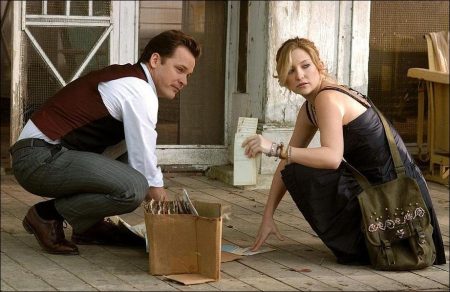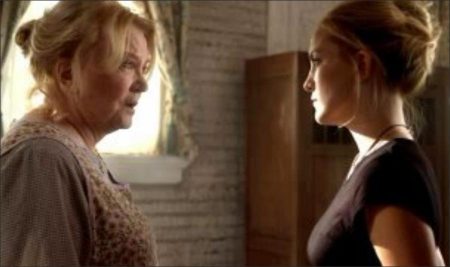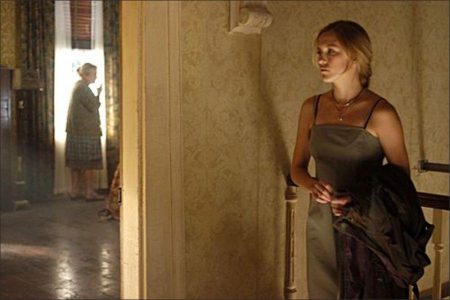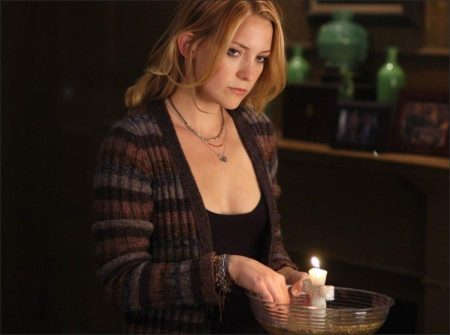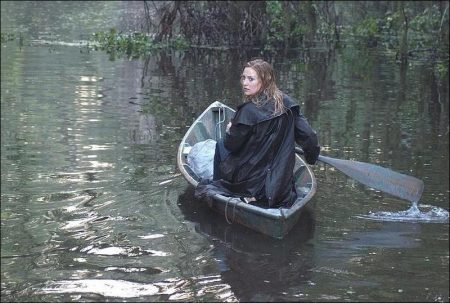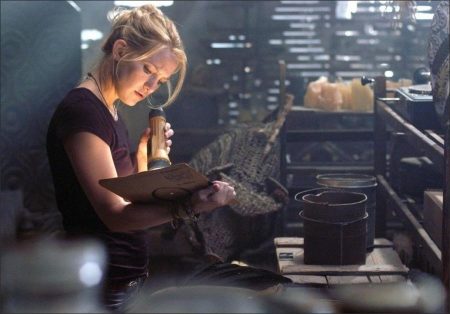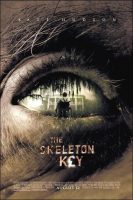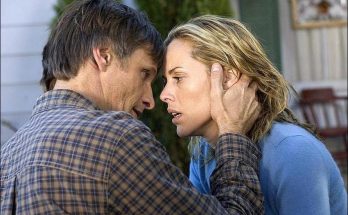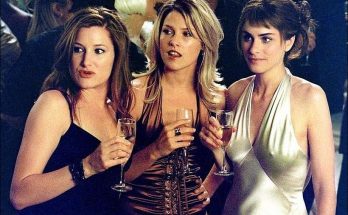About the Production
“I wanted to write a distinctly American, non-traditional ghost story,” says screenwriter Ehren Kruger, who penned the hit thriller The Ring. “The South, especially Louisiana, struck me as a pure American milieu, a cultural melting pot. I thought that one way to create a unique ghost story would be to have the audience question whether or not they are, in fact, seeing a ghost story at all. I also believe that a classic Gothic notion among most human beings is a desire to find out what is behind the forbidden door. I actually wanted to find out for myself what would be behind that attic door.”
The Skeleton Key, a supernatural thriller set in a contemporary setting, struck a chord with director Iain Softley. “Some of my favorite films are psychological thrillers, like Don’t Look Now, Rosemary’s Baby, Angel Heart. I felt that this script followed along the same lines. It was both intelligent and thematically rich, as well as really entertaining.”
A cursory glance at director Iain Softley’s body of work, which also includes Universal’s K-PAX, an intricate meditation on the very nature of reality, seems to offer little common ground. However, on closer examination, a simple thread is found weaving through his work. He supplies, “I wanted this film to be based in reality, not too Gothic or over-stylized, and make full use of the authenticity and the flavor that is unique to this area. What haunts me about pictures like this is the possibility that these worlds still exist. I think audiences are hungry to be scared in the real world of today.
“I thought the script was a wonderful page-turner, and it was so evocative of sense of place-New Orleans and the Deep South-but it also had a wonderful mood. I also thought that it dealt with aging, which is something that makes a lot of people uncomfortable, in a very interesting way. I’ve always been drawn to psychological horror because it deals with our perceptions, what we imagine to be going on. Oftentimes, that is far scarier than anything that is actually represented,” adds Softley.
Producer Daniel Bobker-who brought Kruger’s script to Softley and then to Universal, where producers Michael Shamberg and Stacey Sher came aboard-came to The Skeleton Key on the heels of the enormous task of producing the upcoming Terry Gilliam film, The Brothers Grimm. He sees his latest project as “lushly atmospheric and haunting, which I think the best ghost stories are. You want to feel someone breathing behind your neck and Iain Softley is the ideal kind of director for this material. He’s a naturalist who brings great reality, an almost unnerving quality to what he’s shooting. He’s a director with a tremendous eye for detail and atmosphere and suffusing that with tension and dread. Iain has a gift for getting the dramatic weight out of not only performances, but places, designs, and textures.”
The filmmakers and Softley-who counts among his credits films in varying genres, from The Wings of the Dove, the four-time Academy Award-nominated adaptation of the Henry James novel, to the intriguing drama K-PAX-assembled a cast of powerful award-winning actors to portray the rich characters that inhabit the foreboding Louisiana mansion at the center of The Skeleton Key.
Kate Hudson, nominated for an Academy Award for her luminous performance as Penny Lane in Almost Famous, plays Caroline Ellis, a hospice worker who has recently arrived in New Orleans and is hired by Violet Devereaux to care for her ailing husband, Ben. Hudson, who appears in almost every scene, was selected to create the central character of Caroline early on in the process.
“Kate was the first actress we thought of for the role,” says Softley. “After Daniel Bobker brought the script to me, it went very quickly to Universal. When Kate first saw it, she loved it and was cast. But then, we were hit with a bombshell-Kate became pregnant. We were more than willing to put the production on hold for almost a year until she was ready to begin work. It turned out to be a good decision because I think that the birth of her baby has given her the maturity and added life experiences that have definitely helped give extra layers to what she has brought to the film.”
Daniel Bobker comments, “Kate was such an inspired choice for the role. She’s always has tremendous appeal as an `everywoman,’ which in a horror film makes the suspense and scares that much more visceral and compelling. Kate’s an actress who audiences want to go on a journey with, and this story really shows her range beyond the lighthearted fare she’s shined in previously. We all found her an uncanny fit for Caroline, and her performance energized the entire production.”
The Skeleton Key spotlights Kate in a role she’s never played before. “This is not a lighthearted Kate Hudson,” says Michael Shamberg, producer and partner with Stacey Sher in Double Feature Films. “She’s more mature, a little darker. Kate has a magical quality of being incredibly available to the audience. She’s put into a really scary situation-and someone as relatable as Kate is inspires great empathy, and that makes it even scarier.”
Reflecting on the serious nature of her character, Hudson says, “Caroline is a serious girl which I found intriguing. It was nice not to have to smile all the time. She’s a curious, strong young woman who becomes increasingly isolated as the story unfolds. She want to be a nurse, so she’s a person accustomed to science and the explainable. It takes a great deal to get her to question her beliefs. And nothing about this story is unbelievable, which gets Caroline questioning. That believability is what makes the story so disturbing.”
Hudson, who did all her own stunts, reveals that she loved the physicality of it. “I think the stunt coordinator was surprised to find out that my coordination was pretty good,” laughs Hudson. “I got to break windows, climb up a two-story trellis and crawl through mud in the pouring rain. One day I looked down at my knees and they were black and blue, just like when I was a kid and played soccer. At one point I was actually soaking wet for 15 hours. I loved it. Nothing like going home after a long day’s work with war wounds.”
Peter Sarsgaard, honored with a Golden Globe nomination for his role in Shattered Glass and critically acclaimed for his searing performance in Boys Don’t Cry, was signed to portray the affable southern estate lawyer Luke Marshall, who works for the Devereauxs. “One is never sure if he’s being ingenuous…or not,” describes Sarsgaard of his mysterious character. “He’s a little over his head in a job that becomes increasingly difficult as the story unfolds. He is a nonbeliever and it’s only after he begins to believe that things start to get really frightening.”
Legendary actors with Oscar and Golden Globe nominations and Emmys to their credit, Gena Rowlands and John Hurt play Violet and Ben Devereaux, an enigmatic couple whose surface appearance belies an unspoken and mysterious subtext.
Bobker offers, “The truly classic horror films are often grounded with illustrious actors who make the story feel both immediate and real, in a way that allows the audience to believe in it all. We were extremely lucky to land master thespians like Gena Rowlands and John Hurt to play the Devereauxs, as they provide the Louisiana setting and culture with a layer of exquisite richness and authenticity.”
Producer Stacey Sher comments, “Working with distinguished actors the caliber of Gena Rowlands and John Hurt is like going to acting school for everybody. Gena is so compelling in her part that she looks like she’s lived in that house all her life. And John, who barely has a word of dialogue in the entire film, brings tremendous sympathy to a central role at the crux of the mystery of the house. He is able to drive the movie’s mood and atmosphere and narrative pace without even uttering a word. Who can communicate more without words than John Hurt?”
Gena Rowlands portrays Violet, a faded southern belle living with her husband in a decaying mansion deep in the Louisiana bayou. It soon becomes clear that their relationship is not all that it first appears to be.
Reflecting on her role, Rowlands says, “I play a very spooky old lady who works at keeping Kate’s character, Caroline, off-balance. Violet spends much of her time in her garden because, like Violet herself, a garden transforms itself every year. I can relate to this.”
For the role of Ben Devereaux, whose character is largely confined to a wheel chair, Softley cast the distinguished English actor John Hurt. Well known for his classic role in 1980 film The Elephant Man, Hurt explains what he feels comprise the right ingredients for a good thriller: “Every thread of the story has to be kept visible all the way through…and then paid off neatly. The clues may be disguised a bit, but they must be evident in the end to make the story work. Ehren Kruger has created such a script.”
Producer Sher comments, “Joy brings an effervescent quality to her role. She speaks for the audience, the one who warns Caroline, `Don’t go into that room.’”
“There were many things that attracted me to this project,” says Bryant. “The cast, Iain and his team, the story, the location-it’s this great mix of just the right amount of everything. In that way, it’s kind of like New Orleans itself. There is just so much going on and everywhere you look, there are stories. When you’re there, it doesn’t even really feel like you’re in the States-it’s definitely its own place.”
Giving full reign to their imaginations, Softley and his accomplished team of creative and technical artists fashioned an astonishing backdrop upon which the haunting story plays out, all amidst a fascinating and slightly foreign world of decaying and exotic beauty prevalent in New Orleans and the surrounding bayou.
“I love making a film that could only have taken place here,” says Softley. “I wanted to create an atmosphere that had a gritty, rich photographic look, but at the same time felt a bit strained. I believe that the mood of a place is what creates intrigue and draws in the audience. Kate’s character is a hospice worker-her job is to help people die. This is a central theme to the story and I feel it’s interesting to set a story like that in a place like New Orleans, a place rich in history, where you could say that so much has died in the past. This part of the South has a limpid, rainy quality that is always changing, which give us the opportunity to show the characters in different lights.”
In creating the mystical world of The Skeleton Key, Kruger had included as its centerpiece a particular kind of magic known as Hoodoo, still practiced by some in the bayous and rural areas and utilized for a variety of purposes-healing, control, good (or bad) luck. The practice, to the unschooled, is easily confused with the far better known religion of Voodoo, brought to New Orleans by Haitian slaves in the early 1800s-the religion became so popular there that the Catholic church issued an edict banning all non-Catholic practices within the city limits; the followers of “Voudoun” then moved their ceremonies to Congo Square (now Louis Armstrong Park).
Screenwriter Kruger explains, “While doing research on the supernatural I stumbled on the term Hoodoo, which is essentially an American system of folk magic beliefs. It’s not a religion, whereas Voodoo is a West African Haitian religion. Hoodoo is much more secular and can incorporate numerous religious belief systems. Hoodoo is primarily witchcraft, root work, spells, potions and conjurations. It was brought to this country by slaves from Africa and intermingled with Native American botanical knowledge and European Christian, Jewish and pagan folkloric systems which, when they all came together in this melting pot of a country, created a uniquely American sort of folk magic. It’s an amalgamation of many beliefs.”
Hoodoo, also called “conjure,” emphasizes personal power. Practitioners create a spell (called “conjure,” “trick,” “fix” or “hurt”) in order to heal, protect, attract or, sometimes, harm others. These conjures call for a variety of botanicals, oils, spices, candles and music. The presence of the practice of Hoodoo and the Voodoo religion in New Orleans has become deeply ingrained in the local culture.
In a place where many of the worlds’ religions have intermingled and evolved and where the dead are never far away (because of the city’s high water table, coffins are not buried but entombed in above-ground crypts), an aura of superstition abounds. A mere belief in a Hoodoo curse or the power of Voodoo is often enough to bring about the aims of the conjures-the belief is more powerful than the supposed magic itself.
Delving into the world of Hoodoo required a lot of research on the part of not only the screenwriter, but the director, producers, production designer John Beard and set decorator Beauchamp Fontaine.
“We began looking for spells, wish tails and all kinds of creepy gris gris bags,” explains producer Stacey Sher. “We actually found original Haitian recordings and real conjures, until all of a sudden our lives were filling up with animal bones and skulls. Frankly, it all started to really creep me out. I began to feel I needed to see a witch doctor just to protect myself.”
Set decorator Beauchamp Fontaine, who holds a Master’s degree in cultural anthropology, immersed herself in local culture and folklore. “Our team’s aim was to create a powerful representation of accuracy, which entailed a great deal of research and digging. We found New Orleans author Catherine Yronwode, who wrote Hoodoo in Theory and Practice. We went over the script with her, scene by scene, to ensure accuracy. We even painted the underside of the roof in the Devereaux house blue, because that’s what they do in the South, to keep the birds from nesting and roosting up under the eaves. Even if the audience is not aware of these details on a conscious level, it creates a mood that will make it worthwhile.”
Louisiana was the site for the first half of principal photography. Felicite Plantation, which stands in for the fictitious Devereaux house, the dark heart of the film, was chosen for the first three weeks of filming after it was spotted during location scouting among scores of plantations in Louisiana.
Even without assuming the guise of a home full of secrets, the Felicite Plantation house comes with its own back story. Located deep in St. James Parish, in the Village of Vacherie, halfway between Baton Rouge and New Orleans along the mighty Mississippi, the plantation was built in 1847 by the wealthiest man in the state, Valcour Aime (often referred to as the Louise XIV of Louisiana), who had it constructed as a wedding present for his daughter, Felicite. (His other daughter, Josephine, was the lucky recipient of another plantation a couple miles down River Road from Felicite). After the Civil War, both plantations changed hands. The faded white Greek Revival house, which first appears onscreen through a canopy of enormous oaks, is a home that clearly suggests old-fashioned Southern sensibilities.
Producer Michael Shamberg credits executive and line producer Clayton Townsend with discovering Felicite for the film company. He recalls, “As soon as we saw it we knew it was our mansion. While driving through the area, Iain quickly instructed, `Stop the car! This is it! We are there.’ Clayton jumped the fence, approached the owners and they surprisingly said yes. We were told that filmmakers had been trying unsuccessfully for 25 years to use Felicite, so I guess timing is everything. We found several beautifully restored plantation houses in the area, but this one had everything we needed. It offered the right age, patina and feel. And it certainly had the history.”
Producer Bobker comments, “We had been scouting and hadn’t found just the right house. There was even talk of building the exterior back here in Los Angeles, and just shooting in New Orleans for a month and a half and then doing the house scenes here. But then we found Felicite, and even if we could have constructed something like it, there is no way we could have reproduced the feeling that you get from just walking in a place that was built more than 150 years ago. We talk about atmosphere-it’s built-in here, which truly enriches the actors’ performances and elevates the film.”
Irma and Stan Waguespack, who are in their nineties, are the present residents at Felicite Plantation, where they have lived most of their lives. “My grandmother used to pass by the place a lot of times and always said she wanted to live in a house like this,” recalls Stan, now married to Irma for 62 years. “Finally, my grandfather got a chance to buy it and we’ve been here ever since. I came here as a young child and grew up on this land.”
Hudson remembers, “When we were filming that scene in the canoe, I was sitting there, waiting to shoot, and all around me was this swamp-with mosquitoes like you’ve never experienced and crocodiles. And right before we were to shoot the scene, it got incredibly quiet. I felt utterly alone and terrified…just like Caroline. It was amazing-you can’t re-create that kind of stuff. Even with all the physical demands and the challenges of being on location in the swamps, sometimes I had the easiest job in finding Caroline because everything was right there…all that history bearing down on you.”
The first three weeks of principal photography were executed in the swamps in scenes that called for rain-both real and man-made were utilized. Since New Orleans and the surrounding bayous are situated below sea level, the delta is home to swampy conditions and epic amounts of mud. The presence of stagnant water also gave rise to Biblical-scale swarms of mosquitoes, referred to among locals as the “national bird.” The crew dressed in camouflaged netting for protection and the subject of the most effective insect repellants was almost as well-researched as the Hoodoo featured in the film.
British-born director Softley says, “This was my first visit to this city. I was struck by how truly evocative New Orleans is. I never knew how close the swamp encroached into town, or how vast and beautiful it is. Even though it is largely set in one plantation house out in the Louisiana bayou, I thought the film would have more authenticity if we added some of the wonderful elements and flavors that are unique to this city, including the amazing music.”
The Skeleton Key (2005)
Directed by: Iain Softley
Starring: Kate Hudson, Gena Rowlands, Peter Sarsgaard, John Hurt, Joy Bryant, Deneen Tyler, Ann Dalrymple, Trula M. Marcus, Jen Apgar, Forrest Landis, Thomas Uskali
Screenplay by: Ehren Kruger
Production Design by: John Beard
Cinematography by: Dan Mindel
Film Editing by: Joe Hutshing
Costume Design by: Louise Frogley
Set Decoration by: Beauchamp Fontaine
Art Direction by: Drew Boughton
Music by: Edward Shearmur
MPAA Rating: PG-13 for violence, disturbing images, partial nudity, thematic material.
Distributed by: Universal Pictures
Release Date: August 12, 2005
Visits: 197
